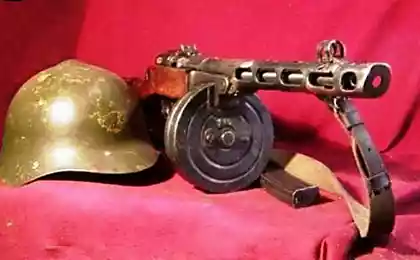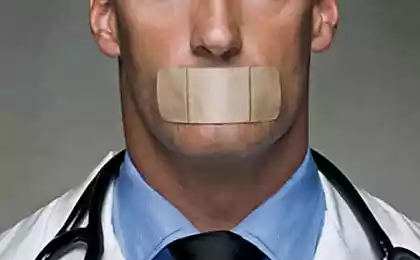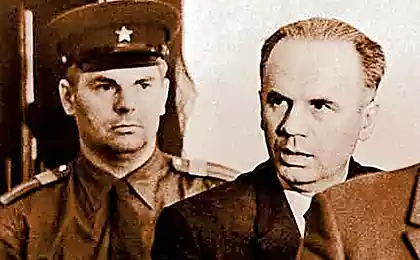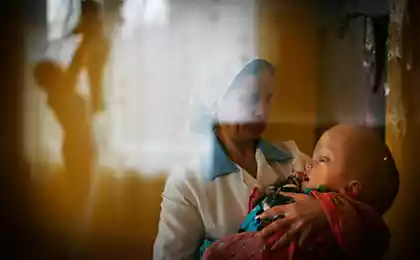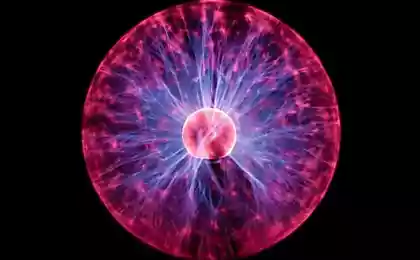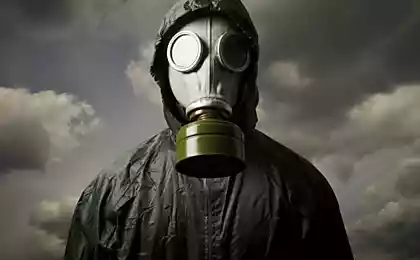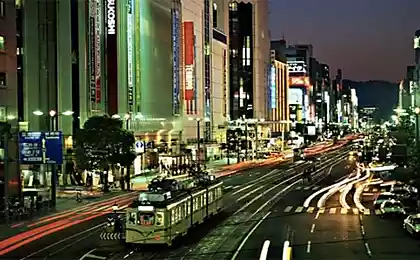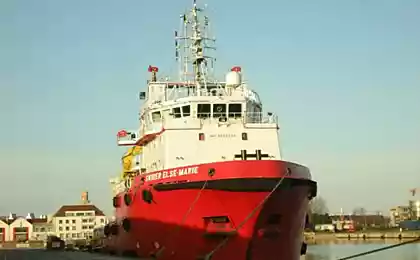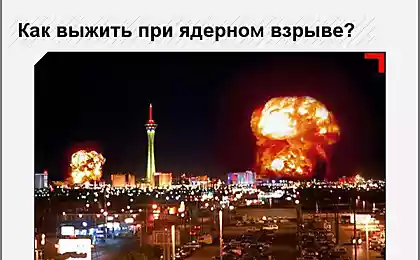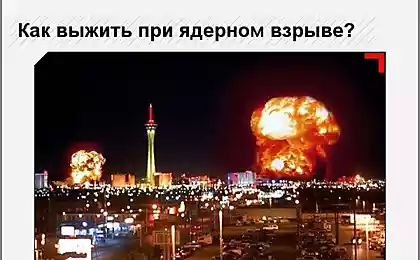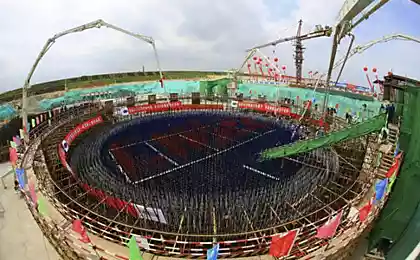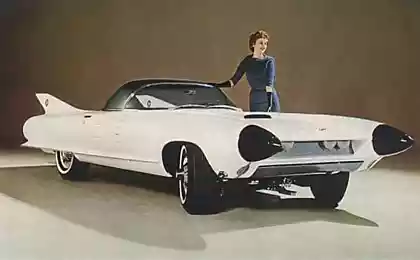2215
Silent on nuclear weapons (35 photos)
Since the first atomic explosion, code-named "Trinity", in 1945, was held for almost two thousand atomic bomb tests, and most of them took place in 60-70s. When the technology was new, tests were carried out frequently, and the spectacle they were something else. They all lead to the development of new and more powerful nuclear weapons. But since the 1990s, governments around the world have begun to limit future nuclear weapons tests - to take at least a moratorium the United States and the UN agreement on a comprehensive test ban nuclear weapons. Who will take care of those experienced engineers, who are now almost lost their jobs, and whether we should behave as our hosts a stockpile of nuclear weapons? Collected here are photos of the first 30 years of testing nuclear bombs.
1. nuclear test explosions «Upshot-Knothole Grable» Nevada May 25, 1953. 280 milimmetrovy nuclear missile flew from the gun M65, detonated in the air - about 150 meters above the ground - and produced a burst of power of 15 kilotons. (U.S. Department of Defense)

2. Open harness nuclear device code-named «The Gadget» (the informal name of the project «Trinity») - the first test of an atomic explosion. The device is prepared for the explosion, which occurred July 16, 1945. (U.S. Department of Defense)
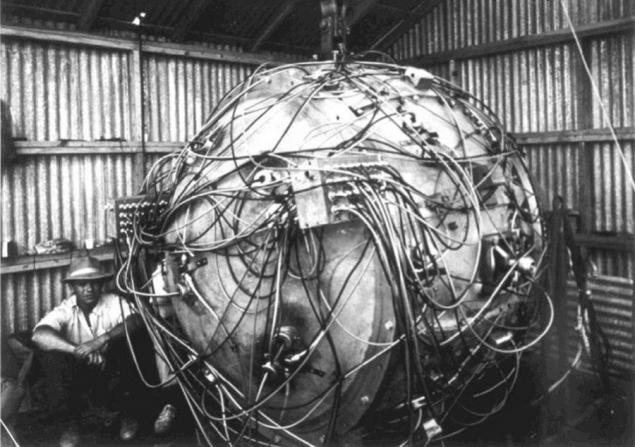
3. Shadow director of Los Alamos National Laboratory, J. Robert Oppenheimer, the observer for the assembly of the projectile «Gadget». (U.S. Department of Defense)
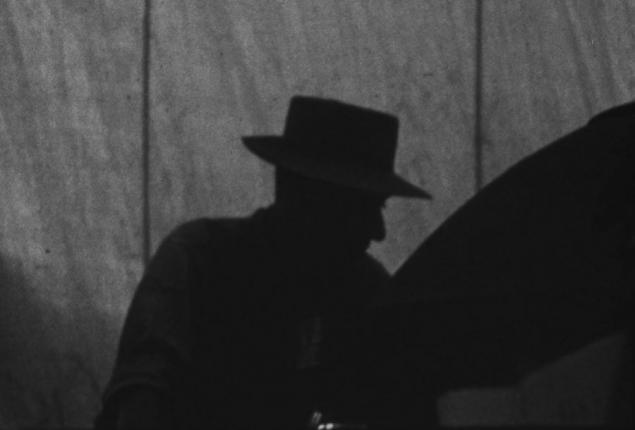
4. The 200-ton steel container "Jumbo", used in the project "Trinity", was made for the recovery of plutonium, if the explosive is not suddenly start a chain reaction. As a result, Jumbo was not useful, but it is placed close to the epicenter, to measure the effects of the explosion. Jumbo survived the explosion, which can not be said about its support frame. (U.S. Department of Defense)

5. Growing fireball and blast wave explosion "Trinity" at 0, 025 seconds after the explosion, 16 July 1945. (U.S. Department of Defense)
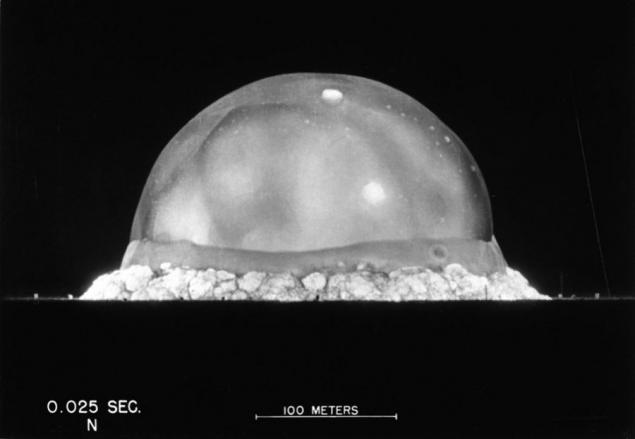
6. Photo Explosion "Trinity" long exposure a few seconds after detonation. (U.S. Department of Defense)
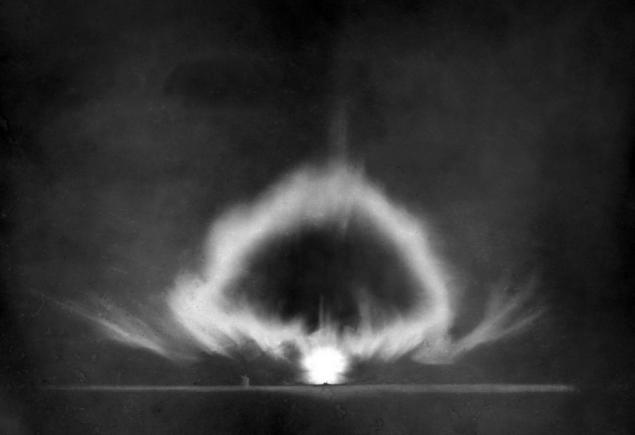
7. Fireball "mold" of the first atomic explosion in the world. (U.S. Department of Defense)

8. The US military is watching explosion during Operation "Crossroads" at Bikini Atoll July 25, 1946. It was the fifth nuclear explosion after the first two test and two atomic bombs dropped on Hiroshima and Nagasaki. (U.S. Department of Defense)
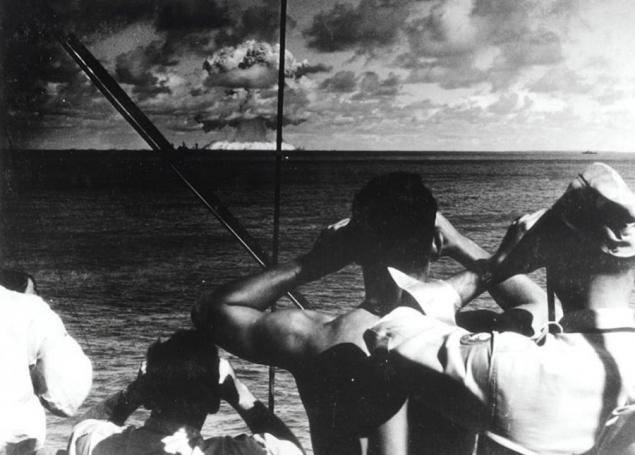
9. Nuclear mushroom and post splashing in the sea during the test of a nuclear bomb at Bikini Atoll in the Pacific Ocean. It was the first underwater test atomic explosion. After the explosion, several former military ships ran aground. (AP Photo)
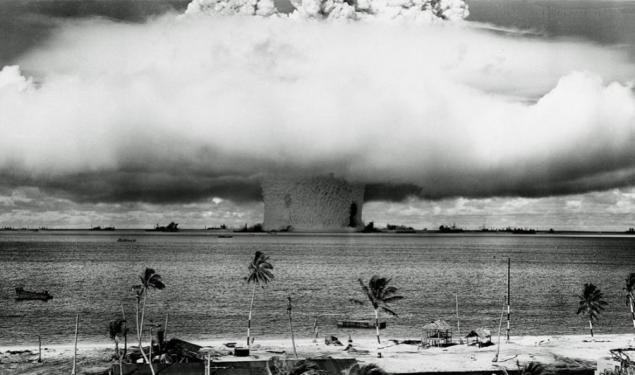
10. A huge mushroom cloud after the bomb at Bikini Atoll July 25, 1946. Dark spots in the foreground - ships, specifically placed in the path of the blast wave to see what she would do with them. (AP Photo)
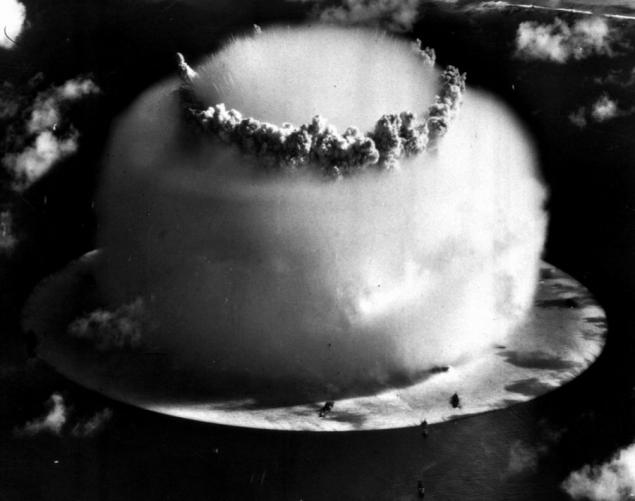
11. November 16, 1952 B-36H bomber dropped an atomic bomb on the northern part of the island Runit on Eniwetok Atoll. The result was an explosion of a capacity of 500 kt and a diameter of 450 meters. (U.S. Department of Defense)
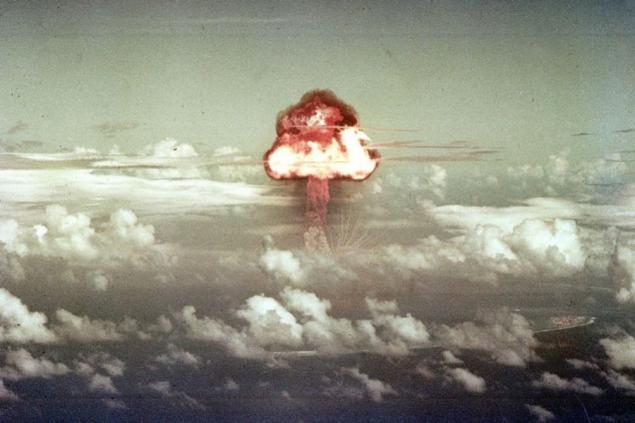
12. Operation "Greenhouse" was held in the spring of 1951. It consisted of four explosions in the Pacific nuclear test site in the Pacific. This is a photo of the third test, codenamed "George", held May 9, 1951. He became the first explosion, which burned deuterium and tritium. Capacity - 225 kilotons. (U.S. Department of Defense)
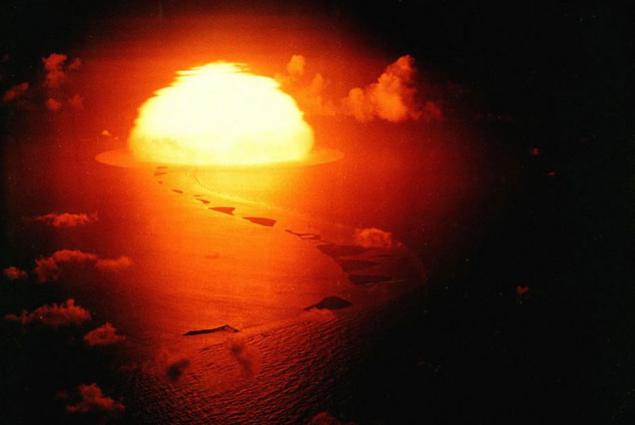
13. "rope trick" nuclear explosion, captured in less than one millisecond after the explosion. During "Operation Tumbler-Snapper" in 1952, is a nuclear device was suspended 90 meters above the Nevada desert on a hawser. With the proliferation of plasma emitted energy overheated cables and evaporate over a fireball, causing and get these "spies." (U.S. Department of Defense)
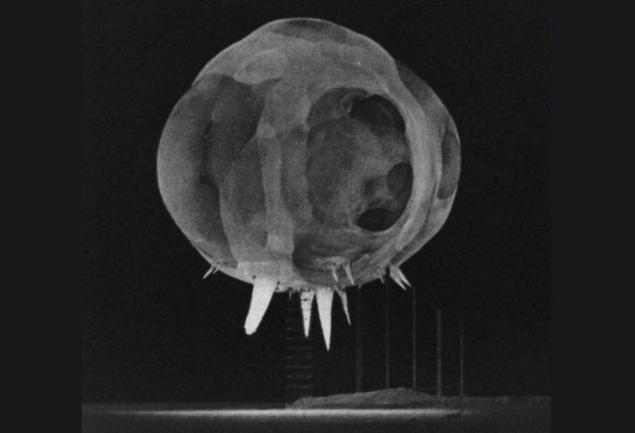
14. During the operation, "Apshot-Nothol" group dummies seated in the dining room at home, to experience the effects of a nuclear explosion on the houses and the people, 15 March 1953. (AP Photo / Dick Strobel)
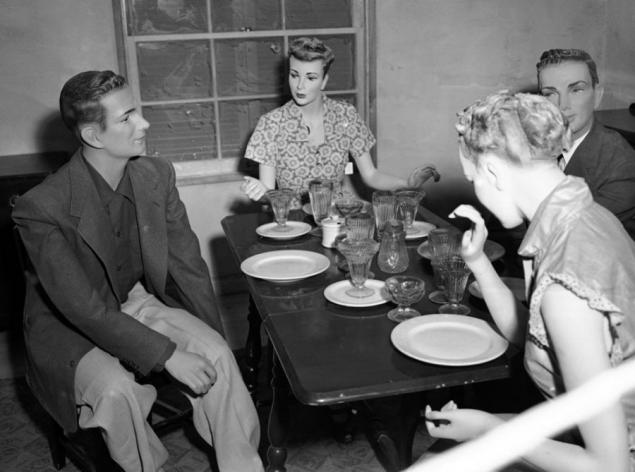
15. This is what happened to them after a nuclear explosion. (U.S. Department of Defense)
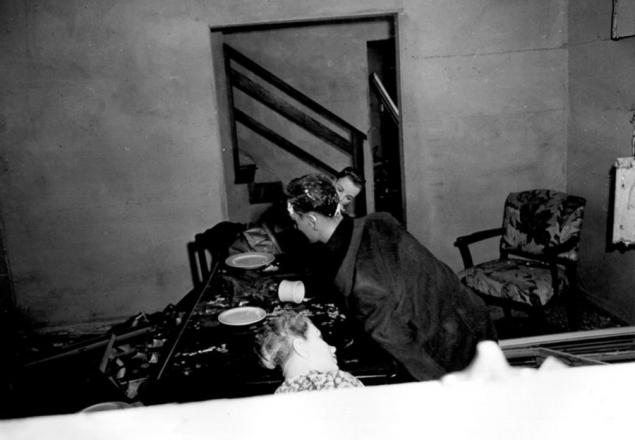
16. In the same house number two on the second floor on the bed lay another mannequin. In the house is visible 90-foot steel tower, which will soon explode a nuclear bomb. The purpose of the test explosion - show people what would happen if a nuclear explosion occurs in an American city. (AP Photo / Dick Strobel)
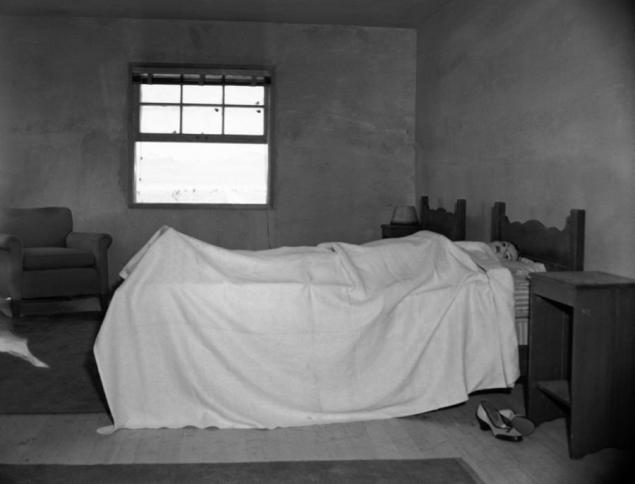
17. Damaged bedroom window and disappeared knows where blankets after the test explosion of the atomic bomb March 17, 1953. (U.S. Department of Defense)
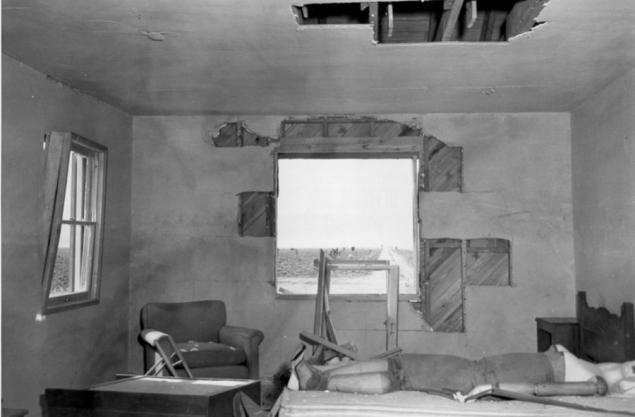
18. mannequins representing a typical American family, living in a test house №2 on the territory of the nuclear test site in Nevada. (AP Photo)
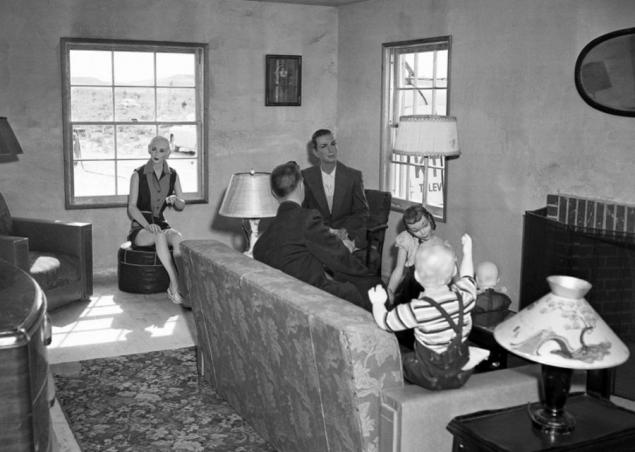
19. The same "family" after the explosion. Someone scattered throughout the living room, someone just disappeared. (U.S. Department of Defense)
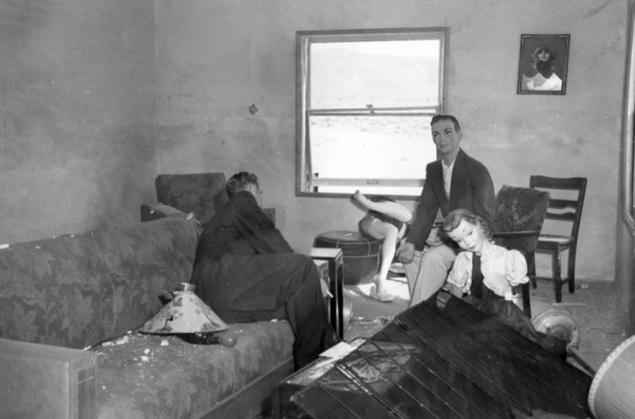
20. During the operation, "Plumb" at the Nevada nuclear test site 30 August 1957 bomb detonated by a ball in the desert Yucca Flat at an altitude of 228 meters. (National Nuclear Security Administration / Nevada Site Office)
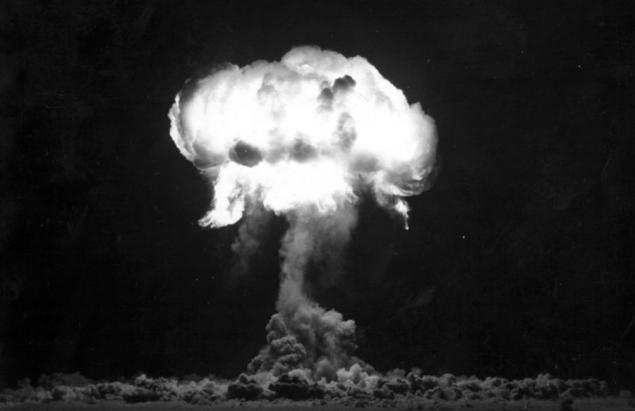
21. The test of a hydrogen bomb explosion during "Operation Redwing" over Bikini Atoll May 20, 1956. (AP Photo)

22. Ionization glow around the cooling fireball in the desert Yucca at 4:30 ktra July 15, 1957. (National Nuclear Security Administration / Nevada Site Office)
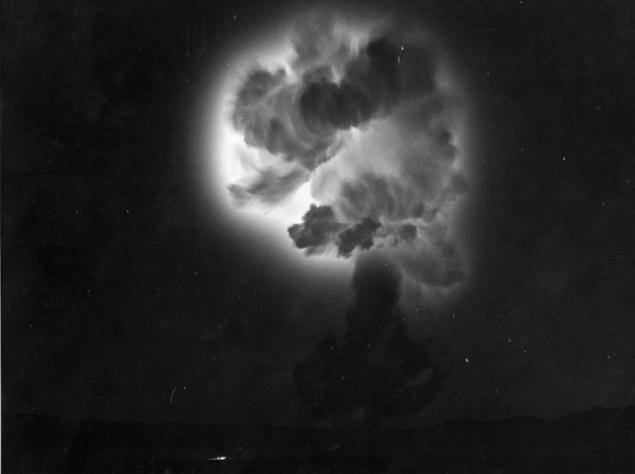
23. Flash exploded a nuclear warhead missiles, air-to-air at 7:30 am July 19, 1957 at the airbase «Indian Springs», 48 km from the explosion site. In the foreground - the same type of aircraft "Scorpion". (National Nuclear Security Administration / Nevada Site Office)
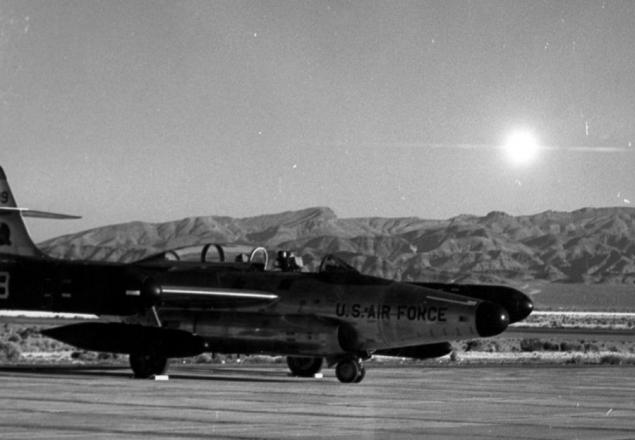
24. fireball projectile "Priscilla" June 24, 1957 during a series of operations "Plummet". (National Nuclear Security Administration / Nevada Site Office)
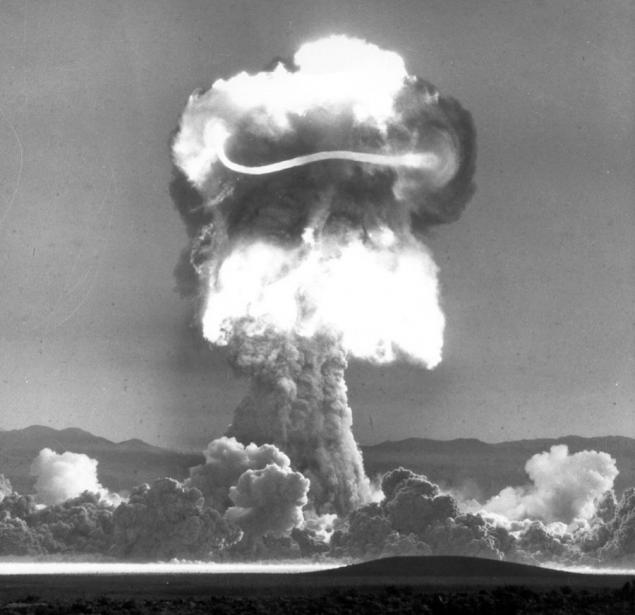
25. NATO officials are watching the explosion when the "Boltzmann" May 28, 1957. (National Nuclear Security Administration / Nevada Site Office)
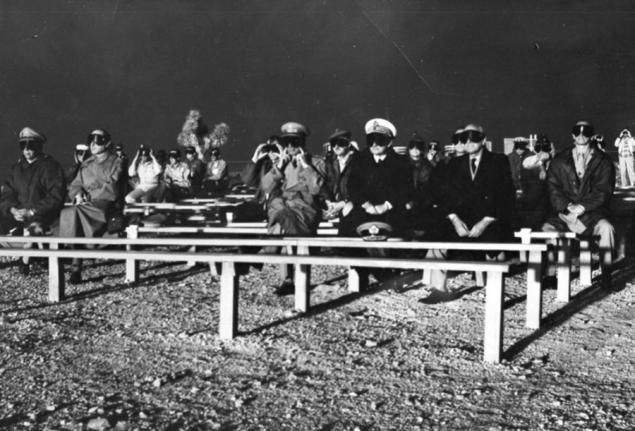
26. The tail of the airship US Navy after the test in Nevada Yao August 7, 1957. Airship hovering in free flight, more than 8 km from the epicenter of the explosion, when he was overtaken by the shock wave. In the airship was empty. (National Nuclear Security Administration / Nevada Site Office)

27. Observers during Operation Hardtack I - the explosion of a thermonuclear bomb in 1958. (National Nuclear Security Administration / Nevada Site Office)
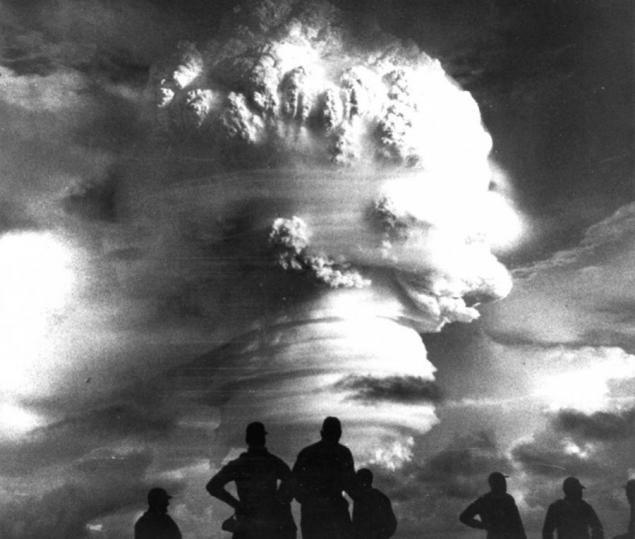
28. Test "Arkansas" - part of "Operation Dominic" - a series of more than a hundred explosions in Nevada and the Pacific Ocean in 1962. (U.S. Department of Defense)
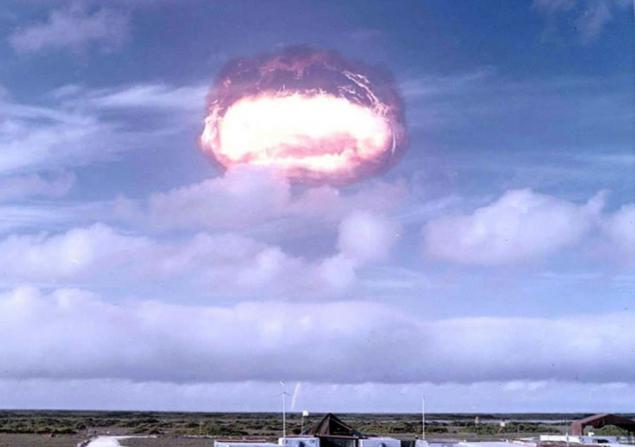
29. Fireball test test "Aztec" is part of "Operation Dominic" in Nevada. (U.S. Department of Defense)
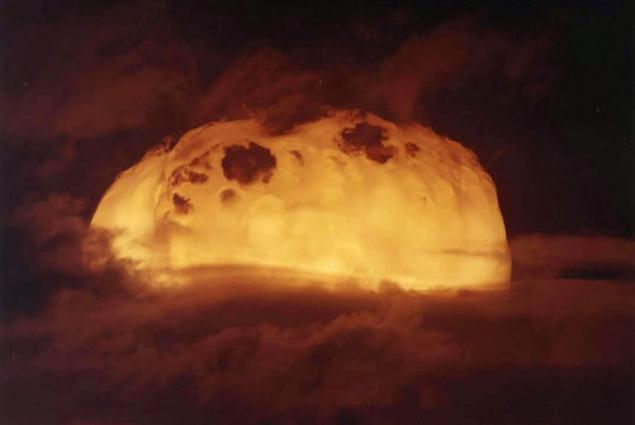
30. Part of a series of high-altitude nuclear tests «Fishbowl Bluegill» - explosion capacity of 400 kt in the atmosphere at an altitude of 48 km over the Pacific Ocean. Top view. October 1962. (U.S. Department of Defense)

31. Ring around a nuclear mushroom during a test project «Yeso» in 1962. (U.S. Department of Defense)

32. Sedan Crater formed after the explosion of 100 kilotons of explosives at a depth of 193 meters below the loose sediments of the desert in Nevada July 6, 1962. Crater turned 97 meters deep and 390 meters in diameter. (National Nuclear Security Administration / Nevada Site Office)
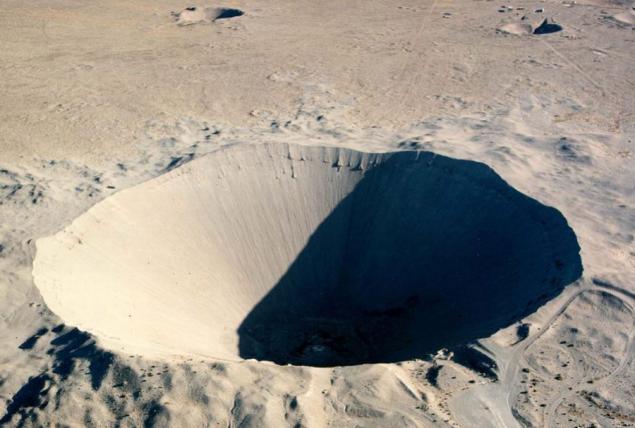
33. Photo nuclear explosion French government at Mururoa Atoll in 1971. (AP Photo)
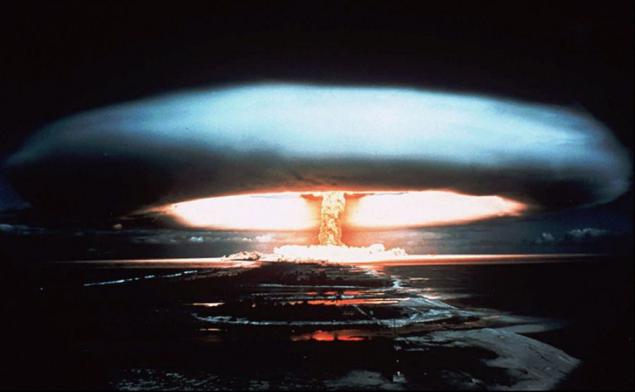
34. The same nuclear explosion at Mururoa Atoll. (Pierre J. / CC BY NC SA)
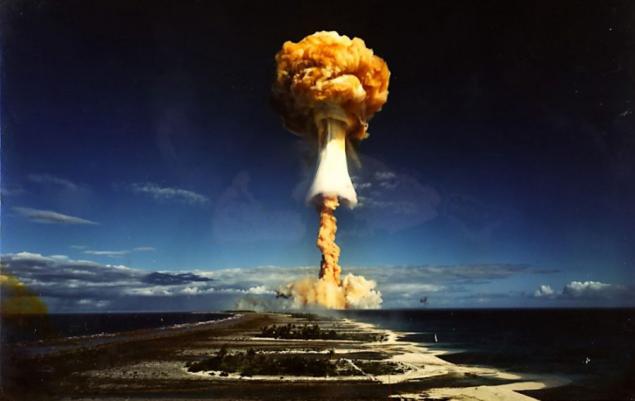
35. "Survivor city" was built in 2286 meters from the epicenter of a nuclear explosion capacity of 29 kilotons. The house has remained virtually intact. "Survivor city" consisted of homes, office buildings, shelters, sources of electricity, communications, radio stations and "residential" vans. Test, codenamed «Apple II» passed May 5, 1955. (U.S. Department of Defense)
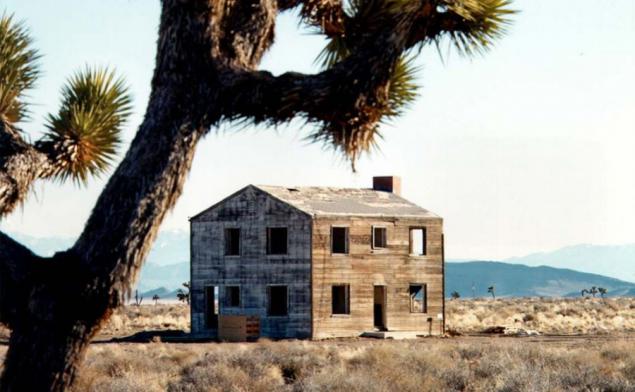
1. nuclear test explosions «Upshot-Knothole Grable» Nevada May 25, 1953. 280 milimmetrovy nuclear missile flew from the gun M65, detonated in the air - about 150 meters above the ground - and produced a burst of power of 15 kilotons. (U.S. Department of Defense)

2. Open harness nuclear device code-named «The Gadget» (the informal name of the project «Trinity») - the first test of an atomic explosion. The device is prepared for the explosion, which occurred July 16, 1945. (U.S. Department of Defense)

3. Shadow director of Los Alamos National Laboratory, J. Robert Oppenheimer, the observer for the assembly of the projectile «Gadget». (U.S. Department of Defense)

4. The 200-ton steel container "Jumbo", used in the project "Trinity", was made for the recovery of plutonium, if the explosive is not suddenly start a chain reaction. As a result, Jumbo was not useful, but it is placed close to the epicenter, to measure the effects of the explosion. Jumbo survived the explosion, which can not be said about its support frame. (U.S. Department of Defense)

5. Growing fireball and blast wave explosion "Trinity" at 0, 025 seconds after the explosion, 16 July 1945. (U.S. Department of Defense)

6. Photo Explosion "Trinity" long exposure a few seconds after detonation. (U.S. Department of Defense)

7. Fireball "mold" of the first atomic explosion in the world. (U.S. Department of Defense)

8. The US military is watching explosion during Operation "Crossroads" at Bikini Atoll July 25, 1946. It was the fifth nuclear explosion after the first two test and two atomic bombs dropped on Hiroshima and Nagasaki. (U.S. Department of Defense)

9. Nuclear mushroom and post splashing in the sea during the test of a nuclear bomb at Bikini Atoll in the Pacific Ocean. It was the first underwater test atomic explosion. After the explosion, several former military ships ran aground. (AP Photo)

10. A huge mushroom cloud after the bomb at Bikini Atoll July 25, 1946. Dark spots in the foreground - ships, specifically placed in the path of the blast wave to see what she would do with them. (AP Photo)

11. November 16, 1952 B-36H bomber dropped an atomic bomb on the northern part of the island Runit on Eniwetok Atoll. The result was an explosion of a capacity of 500 kt and a diameter of 450 meters. (U.S. Department of Defense)

12. Operation "Greenhouse" was held in the spring of 1951. It consisted of four explosions in the Pacific nuclear test site in the Pacific. This is a photo of the third test, codenamed "George", held May 9, 1951. He became the first explosion, which burned deuterium and tritium. Capacity - 225 kilotons. (U.S. Department of Defense)

13. "rope trick" nuclear explosion, captured in less than one millisecond after the explosion. During "Operation Tumbler-Snapper" in 1952, is a nuclear device was suspended 90 meters above the Nevada desert on a hawser. With the proliferation of plasma emitted energy overheated cables and evaporate over a fireball, causing and get these "spies." (U.S. Department of Defense)

14. During the operation, "Apshot-Nothol" group dummies seated in the dining room at home, to experience the effects of a nuclear explosion on the houses and the people, 15 March 1953. (AP Photo / Dick Strobel)

15. This is what happened to them after a nuclear explosion. (U.S. Department of Defense)

16. In the same house number two on the second floor on the bed lay another mannequin. In the house is visible 90-foot steel tower, which will soon explode a nuclear bomb. The purpose of the test explosion - show people what would happen if a nuclear explosion occurs in an American city. (AP Photo / Dick Strobel)

17. Damaged bedroom window and disappeared knows where blankets after the test explosion of the atomic bomb March 17, 1953. (U.S. Department of Defense)

18. mannequins representing a typical American family, living in a test house №2 on the territory of the nuclear test site in Nevada. (AP Photo)

19. The same "family" after the explosion. Someone scattered throughout the living room, someone just disappeared. (U.S. Department of Defense)

20. During the operation, "Plumb" at the Nevada nuclear test site 30 August 1957 bomb detonated by a ball in the desert Yucca Flat at an altitude of 228 meters. (National Nuclear Security Administration / Nevada Site Office)

21. The test of a hydrogen bomb explosion during "Operation Redwing" over Bikini Atoll May 20, 1956. (AP Photo)

22. Ionization glow around the cooling fireball in the desert Yucca at 4:30 ktra July 15, 1957. (National Nuclear Security Administration / Nevada Site Office)

23. Flash exploded a nuclear warhead missiles, air-to-air at 7:30 am July 19, 1957 at the airbase «Indian Springs», 48 km from the explosion site. In the foreground - the same type of aircraft "Scorpion". (National Nuclear Security Administration / Nevada Site Office)

24. fireball projectile "Priscilla" June 24, 1957 during a series of operations "Plummet". (National Nuclear Security Administration / Nevada Site Office)

25. NATO officials are watching the explosion when the "Boltzmann" May 28, 1957. (National Nuclear Security Administration / Nevada Site Office)

26. The tail of the airship US Navy after the test in Nevada Yao August 7, 1957. Airship hovering in free flight, more than 8 km from the epicenter of the explosion, when he was overtaken by the shock wave. In the airship was empty. (National Nuclear Security Administration / Nevada Site Office)

27. Observers during Operation Hardtack I - the explosion of a thermonuclear bomb in 1958. (National Nuclear Security Administration / Nevada Site Office)

28. Test "Arkansas" - part of "Operation Dominic" - a series of more than a hundred explosions in Nevada and the Pacific Ocean in 1962. (U.S. Department of Defense)

29. Fireball test test "Aztec" is part of "Operation Dominic" in Nevada. (U.S. Department of Defense)

30. Part of a series of high-altitude nuclear tests «Fishbowl Bluegill» - explosion capacity of 400 kt in the atmosphere at an altitude of 48 km over the Pacific Ocean. Top view. October 1962. (U.S. Department of Defense)

31. Ring around a nuclear mushroom during a test project «Yeso» in 1962. (U.S. Department of Defense)

32. Sedan Crater formed after the explosion of 100 kilotons of explosives at a depth of 193 meters below the loose sediments of the desert in Nevada July 6, 1962. Crater turned 97 meters deep and 390 meters in diameter. (National Nuclear Security Administration / Nevada Site Office)

33. Photo nuclear explosion French government at Mururoa Atoll in 1971. (AP Photo)

34. The same nuclear explosion at Mururoa Atoll. (Pierre J. / CC BY NC SA)

35. "Survivor city" was built in 2286 meters from the epicenter of a nuclear explosion capacity of 29 kilotons. The house has remained virtually intact. "Survivor city" consisted of homes, office buildings, shelters, sources of electricity, communications, radio stations and "residential" vans. Test, codenamed «Apple II» passed May 5, 1955. (U.S. Department of Defense)

